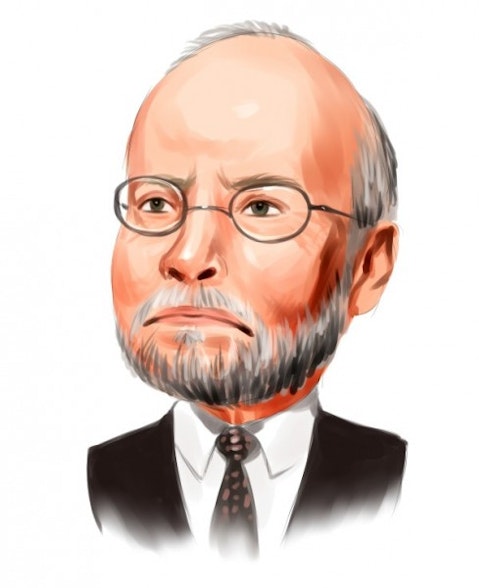In this article we presented the 10 best new stocks to buy in 2021 according to billionaire Paul Singer. You can skip our detailed discussion on Singer’s investment philosophy and read 5 Best New Stocks to Buy in 2021 According to Billionaire Paul Singer.
Paul Elliott Singer is an American billionaire and hedge fund manager who founded Elliott Management in 1977. As of the end of 2020, the fund has $73.5 billion in assets under management and $10.25 billion in managed securities. The fund has posted annualized gains of about 13% in its 44 years, beating the S&P 500 Index. Singer, 76, is often called a “vulture capitalist” because of his strategy of buying distressed debt from troubled companies and sovereign states and going after them through courts and litigation. Labeled by the Fortune magazine as one of the “smartest and toughest” money managers in the hedge fund industry, Singer’s worth stands at $4.3 billion.
Paul Singer’s Warning on ‘Head-Smacking Craziness’
The activist investor has been frank in his warnings about the upcoming market crash amid the Federal Reserve’s policies which he believes are too easy. According to Bloomberg, in a January letter to investors, Singer shared his fears about the future of markets, citing soaring valuations, overleveraged capital structures, “a scarcity of honest profits, a desperate dearth of understanding evinced by the most active traders.”
“We believe that hindsight will show the champion of head-smacking craziness in the American stock market to be the period playing out right now,” Singer reportedly wrote.
Elliott Management’s Returns in 2020
Paul Singer’s hedge fund posted sterling performance in 2020, proving the billionaire’s stock-picking skills in the midst of the global crisis that caused the entire hedge fund industry to waver and struggle to stay afloat. According to Bloomberg, Elliott was profitable in every month of 2020, including March, when the market was clobbered amid a broader selloff following the coronavirus-related shutdowns. The fund returned 12.7% on its investments in 2020, making the year one of its strongest in a decade. Singer attributed the success to his “portfolio-protection trades” related to interest rates and gold, along with his fund’s “core activities” like buying distressed debt, equity activism, and private equity.
‘Doomsday Investor’
One of the reasons why Singer stands out in a market shocked by financial volatility is his agility combined with a strong grasp over market dynamics. The billionaire told Lois Peltz, the author of The New Investment Superstars: 13 Great Investors and Their Strategies for Superior Returns that the world is shifting constantly and you can’t remain stick to certain options for too long.
“You have to be there and you can’t stay in too long. It’s like the Welcome Wagon in front of your house for 10 minutes. You don’t want to be too late and miss the cookies.”
Singer was born in New Jersey to Jewish parents. He went to Harvard Law School after obtaining a B.S. degree in psychology from the University of Rochester. He founded Elliott Management in 1977 and quickly rose to fame with his aggressive and often successful moves. For example, he took control of Delphi Automotive, which was the sole supplier of parts to General Motors and Chrysler. The US Treasury had to pay Elliott Management $12.9 billion in cash and subsidies from the US Treasury’s auto bailout fund. Last year, Singer launched an attack on Twitter as Elliott bought a 9% stake in the company and demanded the ouster of Jack Dorsey. Elliott and Twitter reportedly reached a deal, giving the hedge fund a seat on the company’s board, among other things.
In a 2018 article, The New Yorker called Singer the “Doomsday Investor.”

Paul Singer of Elliott Management
Singer is an exception in an industry that is reeling from losses. The entire hedge fund industry is feeling the reverberations of the changing financial landscape. Its reputation has been tarnished in the last decade, during which its hedged returns couldn’t keep up with the unhedged returns of the market indices. On the other hand, Insider Monkey’s research was able to identify in advance a select group of hedge fund holdings that outperformed the S&P 500 ETFs by more than 124 percentage points since March 2017. Between March 2017 and February 26th 2021 our monthly newsletter’s stock picks returned 197.2%, vs. 72.4% for the SPY. Our stock picks outperformed the market by more than 124 percentage points (see the details here). We were also able to identify in advance a select group of hedge fund holdings that significantly underperformed the market. We have been tracking and sharing the list of these stocks since February 2017 and they lost 13% through November 16th. That’s why we believe hedge fund sentiment is an extremely useful indicator that investors should pay attention to. You can subscribe to our free newsletter on our homepage to receive our stories in your inbox.
Let’s start our list of Paul Singer’s 10 best new stocks to buy in 2021. We analyze the new positions initiated by Elliott Management in the fourth quarter of 2020.
10. Franco-Nevada Corporation (NYSE: FNV)
Value: $6,267,000
Percent of Paul Singer’s 13F Portfolio: 0.06%
No. of Hedge Fund Holders: 27
Canada-based mining company Franco-Nevada ranks 10th in our list of best new stocks to buy according to billionaire Paul Singer as Elliott Management initiated a new stake in the company in the fourth quarter. Recently, the company bought roughly 15% of Vale’s outstanding royalty debentures from the Brazilian Development Bank and the government of Brazil for $538 million. The stock is also a good option for income investors. Earlier this year, Franco-Nevada upped its quarterly dividend by 15.4%. Forward dividend yield of the stock is about 1.04%.
A total of 27 hedge funds tracked by Insider Monkey were bullish FNV at the end of the fourth quarter, down from 31 funds a quarter earlier.
9. Eaton Vance Senior Floating Rate Trust (NYSE: EFR)
Value: $14,322,000
Percent of Paul Singer’s 13F Portfolio: 0.10%
No. of Hedge Fund Holders: 4
Elliott Management built a new stake in Eaton Vance Senior Floating-Rate Trust in the fourth quarter, making the fund one of the best new stocks to buy according to billionaire Paul Singer. Eaton Vance is a fixed income mutual fund that invests in senior, secured floating rate loans. Earlier in April, the fund declared a monthly dividend of $0.065 per share. Forward yield is 5.62%.
As of the end of the fourth quarter, 4 hedge funds in Insider Monkey’s database of 887 funds held stakes in EFT, compared to 3 funds in the third quarter. Saba Capital is the biggest stakeholder in the company, with 3.3 million shares, worth $42.4 million.
8. Pinterest, Inc. (NYSE: PINS)
Value: $11,862,000
Percent of Paul Singer’s 13F Portfolio: 0.11%
No. of Hedge Fund Holders: 95
Image-based social media platform Pinterest, which went public in 2019, ranks 8th on the list of best new stocks to buy according to billionaire Paul Singer. Pinterest stock has lost over 11% in the last 5 days amid concerns about growth and a decline in spending from advertisers. However, investment firm Bernstein recently recommended investors to consider the latest selloff as a buying opportunity. The firm said that its own data shows that PINS might have a surprise for bearish investors. The firm said that the company should benefit from increased ad inventory and upbeat prices.
Alkeon Capital Management is one of the 95 hedge funds tracked by Insider Monkey having stakes in PINS at the end of the fourth quarter. The fund owns over 10.1 million shares of the company. Our calculations show that Pinterest, Inc. (NYSE: PINS) ranks 27th in our list of the 30 Most Popular Stocks Among Hedge Funds.
RLT Capital Management, in their Q4 2020 investor letter, mentioned Pinterest, Inc. (NYSE: PINS). Here is what RLT Capital Management has to say about Pinterest, Inc. in their Q4 2020 investor letter:
“Pinterest (PINS) likes to say that “inspiration” is the foundation for everything that happens on their site, and as our top contributor in 2020, it’s fair to say we’re plenty inspired.
From its launch in March of 2010, PINS was a site wherein users (i.e., “Pinners”) were encouraged to peruse an unending catalog of images (i.e., “Pins”) related to their personal hobbies and/or interests. Perhaps more important than the discovery of “Pins” for your favorite hobby, is the ability to save/organize those “Pins” into collections (i.e., “Boards”).
Lest the notion of pinners pinning pins to their boards tempt a yawn, let’s skip to the desirable demographics of their “valuable audience” (emphases mine):
“Pinterest reaches 335 million monthly active users, two-thirds of whom are female. As of December 2019, our total audience includes 47% of internet users in the U.S. . . . this includes 8 out of 10 moms . . . as well as more than half of all U.S. millennials ages 18-34.”
Even better than those impressive demographics is the reason that sort of audience chooses to visit Pinterest in the first place:
“[Pinners] come to discover ideas for just about anything you can imagine . . . Browsing and saving visual ideas on our service helps Pinners imagine what their future could look like, which helps them go from inspiration to reality. Pinterest is the productivity tool for planning your dream. Dreaming and productivity may seem like polar opposites, but on Pinterest, inspiration enables action and dreams [to] become reality . . .”
While inspired users are one thing, inspired advertisers will be the key to realizing shareholders’ dreams. Along those lines, PINS offers a particularly compelling alignment with the intent-driven efforts of marketers (emphases mine):
“Getting inspiration for your home, your style, or your travel often means that you are actively looking for products and services to buy . . . [since “advertisers are in the business of inspiration”] . . . relevant ads don’t compete with native content on Pinterest; instead, they are content . . . Pinners use our service to get inspiration for things they want to do and buy in their real lives. This journey from ideation to action takes them down the entire purchasing process . . . [this enables advertisers to] have the opportunity to put relevant promoted content in front of Pinners at every stage of the purchasing journey . . .”
Unsurprisingly, PINS was a prime beneficiary of the unique dynamics of 2020. Monthly active users grew by 37% (to 459 million), and with a 48% year-over-year increase in sales, 2020 marked yet another year with impressive top-line growth. And yet, despite ongoing success in growing average revenues per user (a.k.a. “ARPU”), PINS’ global ARPU of $4.26 still remains downright tiny compared to the ARPUs delivered by their social media peers. Case in point: the ARPUs at Snapchat and Facebook were recently ~$9 and ~$32, respectively.
At a plump year-end valuation of ~16x estimated sales for 2021, PINS is likely going to require some growing into. That said, many of the necessary pieces are already in place, and ample green shoots are already apparent. For example:
● On the user front, PINS is still in the early stages of expanding internationally, and continues to iterate on a variety of usability and feature improvements designed to keep existing users inspired and engaged.
● On the revenue side of things, PINS continues to implement the unsexy infrastructure and backend tools that marketers need and want (e.g., analytics, automated bidding, etc.), while also integrating the early pieces of PINS’ nascent – but promising – e-commerce efforts onto the platform.
Although certainly less inspiring at year-end levels than at the portfolio’s entry point of ~$14.90, we remain optimistic that there’s significant runway ahead.”
7. Eaton Vance Floating-Rate Income Trust (NYSE:EFT)
Value: $14,322,000
Percent of Paul Singer’s 13F Portfolio: 0.13%
No. of Hedge Fund Holders: 7
Paul Singer loaded up on EFT in the fourth quarter, building a $14.32 million stake in the trust. EFT is also getting the attention of the smart money, as 7 hedge funds tracked by Insider Monkey reported owning stakes in the company at the end of the fourth quarter, up from 6 funds a quarter earlier.
6. Snap Inc. (NYSE: SNAP)
Value: $70,098,000
Percent of Paul Singer’s 13F Portfolio: 0.68%
No. of Hedge Fund Holders: 63
Social media company Snap is one of the best new stocks to buy according to billionaire Paul Singer. Snap shares have gained 385% over the last 12 months. Recently, investment firm Wedbush upped its rating for Snap stock to Outperform from Neutral with a $75 price target. The firm likes the stock because of its “unique” position to benefit from social commerce, video and augmented reality. Snap stock also received a bullish outlook from Atlantic Equities, which upgraded the stock citing attractive valuation. Snapchat is ramping up its efforts to tap into the booming ecommerce market. Latest media reports suggest that the company is planning to launch an online shopping feature that will recommend clothes based on photos. For that the company recently acquired Screenshop.
According to our database, the number of SNAP’s long hedge funds positions increased at the end of the fourth quarter of 2020. There were 63 hedge funds that hold a position in Snap Inc. compared to 51 funds in the third quarter. The biggest stakeholder of the company is Stephen Mandel’s Lone Pine Capital, with 19.5 million shares, worth $976.9 million.
In their Q4 2020 investor letter, RiverPark Advisors highlighted a few stocks and Snap Inc. (NYSE:SNAP) is one of them. Here is what the fund said:
“Snap shares were our top contributor for the quarter driven by the company’s blow out third quarter earnings. The company grew revenue 52% year over year to $679 million (exceeding Street expectations by $120 million), and management guided to continued strong revenue growth of 47%-50% for the fourth quarter (more than $100 million greater than current estimates). Revenue growth was driven by strong engagement as well as better-than-expected monetization: Daily Active Users grew 18% year over year, they spent more time on the app (total daily time spent by Snapchatters watching Shows increased by over 50%) and created more Snaps (average Snaps created grew 25% year over year), while average revenue per user (ARPU) grew 28%. Additionally, SNAP delivered its most profitable quarter as a public company–adjusted EBITDA turned positive to $56 million for an 8% margin, vastly exceeding expectations of a $45 million loss.
Snap, known for its mobile-only picture and messaging application Snapchat, has a large and growing user base (249 million DAU) that is extremely engaged, opening Snapchat over 30 times every day, and creating, on average, more than 4 billion Snaps per day. Additionally, with less than $3 billion in run rate revenue and an ARPU that is about 1/2 that of Twitter and 1/3 that of Facebook, Snap should be able to more fully monetize its audience as it continues to create more services—content, advertising, gaming and developer tools.”
Click to continue reading and see 5 Best New Stocks to Buy in 2021 According to Billionaire Paul Singer.
Suggested articles:
- 10 Best Software Stocks To Buy According To Billionaire Chase Coleman
- Balaji Srinivasan’s Top 10 Investments, Portfolio and Ideas
- 10 Best Dividend Stocks According to George Soros
Disclosure: None. 10 Best New Stocks to Buy in 2021 According to Billionaire Paul Singer is originally published on Insider Monkey.





